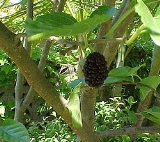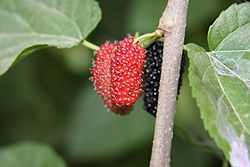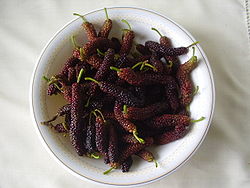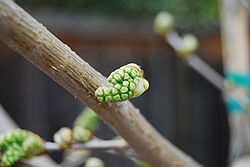
Mulberry
Encyclopedia




Genus
In biology, a genus is a low-level taxonomic rank used in the biological classification of living and fossil organisms, which is an example of definition by genus and differentia...
of flowering plant
Flowering plant
The flowering plants , also known as Angiospermae or Magnoliophyta, are the most diverse group of land plants. Angiosperms are seed-producing plants like the gymnosperms and can be distinguished from the gymnosperms by a series of synapomorphies...
s in the family Moraceae
Moraceae
Moraceae — often called the mulberry family or fig family — are a family of flowering plants comprising about 40 genera and over 1000 species. Most are widespread in tropical and subtropical regions, less so in temperate climates...
. The 10–16 species of deciduous
Deciduous
Deciduous means "falling off at maturity" or "tending to fall off", and is typically used in reference to trees or shrubs that lose their leaves seasonally, and to the shedding of other plant structures such as petals after flowering or fruit when ripe...
tree
Tree
A tree is a perennial woody plant. It is most often defined as a woody plant that has many secondary branches supported clear of the ground on a single main stem or trunk with clear apical dominance. A minimum height specification at maturity is cited by some authors, varying from 3 m to...
s it contains are commonly known as Mulberries.
The closely related genus Broussonetia
Broussonetia
Broussonetia is a genus of four species of trees in the family Moraceae, native to eastern Asia.-References:*...
is also commonly known as mulberry, notably the Paper Mulberry
Paper Mulberry
The Paper Mulberry is a tree in the family Moraceae, native to eastern Asia. Other names include Dak, Halibun, Kalivon, Kozo, and Tapacloth tree.It is a deciduous tree growing to tall...
, Broussonetia papyrifera. Mulberries are swift-growing when young, but soon become slow-growing and rarely exceed 10 – tall. The leaves
Leaf
A leaf is an organ of a vascular plant, as defined in botanical terms, and in particular in plant morphology. Foliage is a mass noun that refers to leaves as a feature of plants....
are alternately arranged, simple, often lobed, more often lobed on juvenile shoots than on mature trees, and serrated on the margin.
Depending on the species, they can be monoecious or dioecious
Dioecious
Dioecy is the property of a group of biological organisms that have males and females, but not members that have organs of both sexes at the same time. I.e., those whose individual members can usually produce only one type of gamete; each individual organism is thus distinctly female or male...
.
The fruit
Fruit
In broad terms, a fruit is a structure of a plant that contains its seeds.The term has different meanings dependent on context. In non-technical usage, such as food preparation, fruit normally means the fleshy seed-associated structures of certain plants that are sweet and edible in the raw state,...
is a multiple fruit, 2 – long. The fruits when immature are white or green to pale yellow with pink edges. In most species the fruits are red when they are ripening, turning dark purple to black and have a sweet flavor. The fruits of the white-fruited cultivar
Cultivar
A cultivar'Cultivar has two meanings as explained under Formal definition. When used in reference to a taxon, the word does not apply to an individual plant but to all those plants sharing the unique characteristics that define the cultivar. is a plant or group of plants selected for desirable...
of the white mulberry are green when young and white when ripe; the fruit in this cultivar is also sweet but has a very mild flavor compared with the darker variety.
Species
The taxonomy of Morus is complex and disputed. Over 150 species names have been published, and although differing sources may cite different selections of accepted names, only 10–16 are generally cited as being accepted by the vast majority of botanical authorities. Morus classification is even further complicated by widespread hybridisation, wherein the hybrids are fertile.The following species are generally accepted:
|
|
The following, all from eastern and southern Asia, are additionally accepted by one or more taxonomic lists or studies; synonymy, as given by other lists or studies, is indicated in square brackets:
|
|
Uses and cultivation
The ripe fruit is edible and is widely used in pies, tarts, wines, cordials and tea. The fruit of the black mulberry, native to southwest Asia, and the red mulberry, native to eastern North America, have the strongest flavor. The fruit of the white mulberry, an east Asian species which is extensively naturalized in urban regions of eastern North America, has a different flavor, sometimes characterized as insipid. The mature plant contains significant amounts of resveratrolResveratrol
Resveratrol is a stilbenoid, a type of natural phenol, and a phytoalexin produced naturally by several plants when under attack by pathogens such as bacteria or fungi....
, particularly in stem bark. The fruit and leaves are sold in various forms as nutritional supplements. Unripe fruit and green parts of the plant have a white sap that is intoxicating and mildly hallucinogenic.
Black, red, and white mulberry are widespread in Albania
Albania
Albania , officially known as the Republic of Albania , is a country in Southeastern Europe, in the Balkans region. It is bordered by Montenegro to the northwest, Kosovo to the northeast, the Republic of Macedonia to the east and Greece to the south and southeast. It has a coast on the Adriatic Sea...
, Azerbaijan
Azerbaijan
Azerbaijan , officially the Republic of Azerbaijan is the largest country in the Caucasus region of Eurasia. Located at the crossroads of Western Asia and Eastern Europe, it is bounded by the Caspian Sea to the east, Russia to the north, Georgia to the northwest, Armenia to the west, and Iran to...
, Armenia
Armenia
Armenia , officially the Republic of Armenia , is a landlocked mountainous country in the Caucasus region of Eurasia...
, Northern India
India
India , officially the Republic of India , is a country in South Asia. It is the seventh-largest country by geographical area, the second-most populous country with over 1.2 billion people, and the most populous democracy in the world...
, Jordan
Jordan
Jordan , officially the Hashemite Kingdom of Jordan , Al-Mamlaka al-Urduniyya al-Hashemiyya) is a kingdom on the East Bank of the River Jordan. The country borders Saudi Arabia to the east and south-east, Iraq to the north-east, Syria to the north and the West Bank and Israel to the west, sharing...
, Syria
Syria
Syria , officially the Syrian Arab Republic , is a country in Western Asia, bordering Lebanon and the Mediterranean Sea to the West, Turkey to the north, Iraq to the east, Jordan to the south, and Israel to the southwest....
, Lebanon
Lebanon
Lebanon , officially the Republic of LebanonRepublic of Lebanon is the most common term used by Lebanese government agencies. The term Lebanese Republic, a literal translation of the official Arabic and French names that is not used in today's world. Arabic is the most common language spoken among...
, Georgia
Georgia (country)
Georgia is a sovereign state in the Caucasus region of Eurasia. Located at the crossroads of Western Asia and Eastern Europe, it is bounded to the west by the Black Sea, to the north by Russia, to the southwest by Turkey, to the south by Armenia, and to the southeast by Azerbaijan. The capital of...
, Pakistan
Pakistan
Pakistan , officially the Islamic Republic of Pakistan is a sovereign state in South Asia. It has a coastline along the Arabian Sea and the Gulf of Oman in the south and is bordered by Afghanistan and Iran in the west, India in the east and China in the far northeast. In the north, Tajikistan...
, Iran
Iran
Iran , officially the Islamic Republic of Iran , is a country in Southern and Western Asia. The name "Iran" has been in use natively since the Sassanian era and came into use internationally in 1935, before which the country was known to the Western world as Persia...
, Turkey
Turkey
Turkey , known officially as the Republic of Turkey , is a Eurasian country located in Western Asia and in East Thrace in Southeastern Europe...
, Egypt
Egypt
Egypt , officially the Arab Republic of Egypt, Arabic: , is a country mainly in North Africa, with the Sinai Peninsula forming a land bridge in Southwest Asia. Egypt is thus a transcontinental country, and a major power in Africa, the Mediterranean Basin, the Middle East and the Muslim world...
, Libya
Libya
Libya is an African country in the Maghreb region of North Africa bordered by the Mediterranean Sea to the north, Egypt to the east, Sudan to the southeast, Chad and Niger to the south, and Algeria and Tunisia to the west....
and Afghanistan
Afghanistan
Afghanistan , officially the Islamic Republic of Afghanistan, is a landlocked country located in the centre of Asia, forming South Asia, Central Asia and the Middle East. With a population of about 29 million, it has an area of , making it the 42nd most populous and 41st largest nation in the world...
, where the tree and the fruit are known by the Persian
Persian language
Persian is an Iranian language within the Indo-Iranian branch of the Indo-European languages. It is primarily spoken in Iran, Afghanistan, Tajikistan and countries which historically came under Persian influence...
-derived names toot (mulberry) or shahtoot (King's or "superior" mulberry). Jams and sherbet
Sherbet
Sherbet may refer to:- Foodstuffs :* Sherbert , an effervescent drink or a fizzy powder sweet, chiefly UK* Sherbert, an American term for a frozen dessert like sorbet, but containing a small amount of dairy...
s are often made from the fruit in this region. Black mulberry was imported to Britain in the 17th century in the hope that it would be useful in the cultivation of silkworms. It was much used in folk medicine
Folk medicine
-Description:Refers to healing practices and ideas of body physiology and health preservation known to a limited segment of the population in a culture, transmitted informally as general knowledge, and practiced or applied by anyone in the culture having prior experience.All cultures and societies...
, especially in the treatment of ringworm. In USA, black mulberry was imported from Pakistan(hence named Pakistan black mulberry in USA). Mulberries are also widespread in Greece
Greece
Greece , officially the Hellenic Republic , and historically Hellas or the Republic of Greece in English, is a country in southeastern Europe....
, particularly in the Peloponnese
Peloponnese
The Peloponnese, Peloponnesos or Peloponnesus , is a large peninsula , located in a region of southern Greece, forming the part of the country south of the Gulf of Corinth...
, which in the Middle Ages
Middle Ages
The Middle Ages is a periodization of European history from the 5th century to the 15th century. The Middle Ages follows the fall of the Western Roman Empire in 476 and precedes the Early Modern Era. It is the middle period of a three-period division of Western history: Classic, Medieval and Modern...
was known as Morea , deriving from the Greek word for the tree .
Mulberry leaves, particularly those of the white mulberry, are ecologically important as the sole food source of the silkworm (Bombyx mori
Bombyx mori
The silkworm is the larva or caterpillar of the domesticated silkmoth, Bombyx mori . It is an economically important insect, being a primary producer of silk...
, named after the mulberry genus Morus), the pupa/cocoon of which is used to make silk. Other Lepidoptera
Lepidoptera
Lepidoptera is a large order of insects that includes moths and butterflies . It is one of the most widespread and widely recognizable insect orders in the world, encompassing moths and the three superfamilies of butterflies, skipper butterflies, and moth-butterflies...
larva
Larva
A larva is a distinct juvenile form many animals undergo before metamorphosis into adults. Animals with indirect development such as insects, amphibians, or cnidarians typically have a larval phase of their life cycle...
e also sometimes feed on the plant including common emerald
Common Emerald
The Common Emerald is a moth of the family Geometridae. The species is found throughout the Nearctic and Palearctic regions and the Near East. In the British Isles it is not found in Scotland but is a common species elsewhere...
, lime hawk-moth, and the sycamore
Sycamore (moth)
The sycamore is a moth of the family Noctuidae. It is distributed through most of Europe, from central England south to Morocco. To the east it is found from the Near East and Middle East to West Asia....
.
Mulberries can be grown from seed, and this is often advised as seedling-grown trees are generally of better shape and health. But they are most often planted from large cuttings which root readily.
The mulberry plants which are allowed to grow tall with a crown height of 5 - 6 feet from the ground level having stem girth of 4 -5 inches or more is called tree mulberry. They are specially raised with the help of well grown saplings of 8 - 10 months old with any of the varieties recommended for rain fed areas like S-13 (for red loamy soil) or S-34 (black cotton soil) which are tolerant to draught or soil moisture stress conditions. Usually the plantation is raised as block plantation with a spacing of 6 feet x 6 feet or 8 feet x 8 feet as plant to plant and row to row distance. The plants are usually pruned once in a year during monsoon (July - August) at a height of 5 - 6 feet from the ground level and allowed to grow with maximum of 8 - 10 shoots at crown. The leaf is harvested 3-4 times in a year by leaf picking method under rain fed or semi-arid conditions depending upon the monsoon.
The tree branches pruned during the fall season (after the leaves have fallen) are cut and used to make very durable baskets which are used in a lot of village jobs related to agriculture and animal husbandry.
Some North American cities have banned the planting of mulberries because of the large amounts of pollen they produce, posing a potential health hazard for some pollen allergy sufferers.
Anthocyanins from mulberry fruits
Anthocyanins are pigments which hold potential use as dietary modulators of mechanisms for various diseases and as natural food colorants. Due to increasing demand for natural food colorants, their significance in the food industry is increasing. Anthocyanins are responsible for the attractive colors of fresh plant foods, producing colors such as orange, red, purple, black, and blue. They are water-soluble and easily extractable.A cheap and industrially feasible method to purify anthocyanins from mulberry fruit which could be used as a fabric tanning
Tanning
Tanning is the making of leather from the skins of animals which does not easily decompose. Traditionally, tanning used tannin, an acidic chemical compound from which the tanning process draws its name . Coloring may occur during tanning...
agent or food colorant of high color value (of above 100) has been established. Scientists found that out of 31 Chinese mulberry cultivars tested, the total anthocyanin yield varied from 148 mg to 2725 mg per liter of fruit juice. Total sugars, total acids, and vitamins remained intact in the residual juice after removal of anthocyanins and that the residual juice could be fermented to produce products such as juice, wine, and sauce.
Anthocyanin content depends on climate, area of cultivation, and is particularly higher in sunny climates. This finding holds promise for tropical sericulture
Sericulture
Sericulture, or silk farming, is the rearing of silkworms for the production of raw silk.Although there are several commercial species of silkworms, Bombyx mori is the most widely used and intensively studied. According to Confucian texts, the discovery of silk production by B...
countries to profit from industrial anthocyanin production from mulberry through anthocyanin recovery.
This offers a challenging task to the mulberry germplasm
Germplasm
A germplasm is a collection of genetic resources for an organism. For plants, the germplasm may be stored as a seed collection or, for trees, in a nursery.-See also:*Germ plasm, the germ cell determining zone...
resources for
- exploration and collection of fruit yielding mulberry species;
- their characterization, cataloging, and evaluation for anthocyanin content by using traditional as well as modern means and biotechnologyBiotechnologyBiotechnology is a field of applied biology that involves the use of living organisms and bioprocesses in engineering, technology, medicine and other fields requiring bioproducts. Biotechnology also utilizes these products for manufacturing purpose...
tools; - developing an information system about these cultivarCultivarA cultivar'Cultivar has two meanings as explained under Formal definition. When used in reference to a taxon, the word does not apply to an individual plant but to all those plants sharing the unique characteristics that define the cultivar. is a plant or group of plants selected for desirable...
s or varieties; - training and global coordination of genetic stocks;
- evolving suitable breeding strategies to improve the anthocyanin content in potential breeds by collaboration with various research stations in the field of sericulture, plant genetics, and breeding, biotechnology and pharmacologyPharmacologyPharmacology is the branch of medicine and biology concerned with the study of drug action. More specifically, it is the study of the interactions that occur between a living organism and chemicals that affect normal or abnormal biochemical function...
.
In popular culture
The nursery rhymeNursery rhyme
The term nursery rhyme is used for "traditional" poems for young children in Britain and many other countries, but usage only dates from the 19th century and in North America the older ‘Mother Goose Rhymes’ is still often used.-Lullabies:...
Here We Go Round the Mulberry Bush
Here We Go Round the Mulberry Bush
Here We Go Round the Mulberry Bush is a 1967 British film made based on the novel of the same name by Hunter Davies. It was listed to compete at the 1968 Cannes Film Festival, but the festival was cancelled due to the events of May 1968 in France....
uses the tree in the refrain, as do some contemporary American versions of the nursery rhyme Pop Goes the Weasel
Pop Goes the Weasel
"Pop! Goes the Weasel" is an English language nursery rhyme and singing game. It has a Roud Folk Song Index number of 5249.-Lyrics:There are many different versions of the lyrics to the song...
.
External links
- Flora of China: Morus
- Flora of North America: Morus
- University of Melbourne: Sorting Morus names
- Propagation (growing) by vegetative method
- Propagation (growing) by seed method
- 300 year old Japanese mulberry tree
- Central Sericultural Germplasm Resources Centre Ministry of Textiles Government of India

